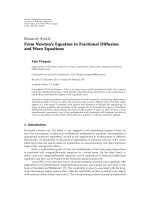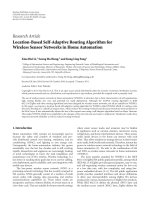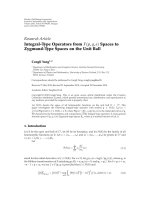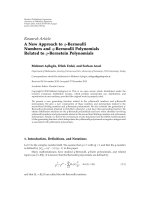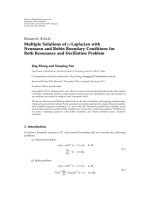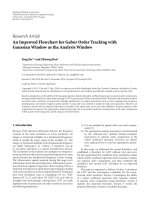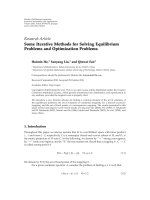Báo cáo hóa học: " Research Article Weighted Composition Operators between Mixed Norm Spaces ∞ and Hα Spaces in the Unit Ball" docx
Bạn đang xem bản rút gọn của tài liệu. Xem và tải ngay bản đầy đủ của tài liệu tại đây (516.09 KB, 9 trang )
Hindawi Publishing Corporation
Journal of Inequalities and Applications
Volume 2007, Article ID 28629, 9 pages
doi:10.1155/2007/28629
Research Article
Weighted Composition Operators between Mixed Norm Spaces
and H
∞
α
Spaces in the Unit Ball
Stevo Stevi
´
c
Received 15 March 2007; Accepted 1 November 2007
Recommended by Ulrich Abel
Let ϕ be an analytic self-map and let u be a fixed analytic function on the open unit
ball B in
C
n
. The boundedness and compactness of the weighted composition operator
uC
ϕ
f = u· (f ◦ ϕ)betweenmixednormspacesandH
∞
α
are studied.
Copyright © 2007 Stevo Stevi
´
c. This is an open access article distributed under the Cre-
ative Commons Attribution License, which permits unrestricted use, distribution, and
reproduction in any medium, provided the original work is properly cited.
1. Introduction
Let B be the open unit ball in
C
n
, ∂B = S its boundary, D the unit disk in C, dV the
normalized Lebesgue volume measure on B, dσ the normalized surface measure on S,
and H(B) the class of all functions analytic on B.
An analytic self-map ϕ : B
→B induces the composition operator C
ϕ
on H(B), defined
by C
ϕ
( f )(z) = f (ϕ(z)) for f ∈ H(B). It is interesting to provide a functional theoretic
characterization of when ϕ induces a bounded or compact composition operator on var-
ious spaces. The book [1] contains a plenty of information on t his topic. Let u be a fixed
analytic function on the open unit ball. Define a linear operator uC
ϕ
, called a weighted
composition operator, by uC
ϕ
f = u·( f ◦ ϕ), where f is an analytic function on B.Wecan
regard this operator as a generalization of the multiplication oper ator M
u
( f ) = uf and a
composition operator.
A positive continuous function φ on [0,1) is called normal i f there exist numbers s
and t,0<s<t,suchthatφ(r)/(1
− r)
s
decreasingly converges to zero and φ(r)/(1 − r)
t
increasingly tends to ∞,asr→1
−
(see, e.g., [2]).
For 0 <p<
∞,0<q<∞, and a normal function φ,letH(p, q,φ) denote the space of
all f
∈ H(B)suchthat
2 Journal of Inequalities and Applications
f
H(p,q,φ)
=
1
0
M
p
q
( f ,r)
φ
p
(r)
1 − r
dr
1/p
< ∞, (1.1)
where M
q
( f ,r) = (
S
| f (rζ)|
q
dσ(ζ))
1/q
,0≤ r<1.
For 1
≤ p<∞, H(p,q,φ), equipped with the norm ·
H(p,q,φ)
, is a Banach space. When
0 <p<1,
f
H(p,q,φ)
is a quasinorm on H(p,q, φ), and H(p,q,φ)isaFrechetspacebut
not a Banach space. Note that if 0 <p
= q<∞,thenH(p, p,φ)becomesaBergman-type
space, and if φ(r)
= (1 − r)
(γ+1)/p
, γ>−1, then H(p, p,φ) is equivalent to the classical
weighted Bergman space A
p
γ
(B).
For α
≥ 0, we define the weig hted space H
∞
α
(B) = H
∞
α
as the subspace of H(B)con-
sisting of all f such that
f
H
∞
α
= sup
z∈B
(1 −|z|
2
)
α
| f (z)| < ∞. Note that for α = 0, H
∞
α
becomes the space of all bounded analytic functions H
∞
(B). We also define a little ver-
sion of H
∞
α
, denoted by H
∞
α,0
(B), as the subset of H
∞
α
consisting of all f ∈ H(B)suchthat
lim
|z|→1−0
(1 −|z|
2
)
α
| f (z)|=0. It is easy to see that H
∞
α,0
is a subspace of H
∞
α
.Notealso
that for α
= 0, in view of the maximum modulus theorem, we obtain H
∞
0,0
={0}.
For the case of the unit disk, in [3], Ohno has characterized the boundedness and
compactness of weighted composition operators between H
∞
and the Bloch space Ꮾ
and the little Bloch space Ꮾ
0
.In[4], Li and Stevi
´
c extend the main results in [3]inthe
settings of the unit ball. In [ 5], A. K. Sharma and S. D. Sharma studied the boundedness
and compactness of uC
ϕ
: H
∞
α
(D)→A
p
γ
(D)forthecaseofp ≥ 1. For related results in the
setting of the unit ball, see, for example, [1, 6, 7] and the references therein.
Here, we study the weighted composition operators between the mixed norm spaces
H(p,q,φ)andH
∞
α
(or H
∞
α,0
). As corollaries, we obtain the complete characterizations of
the boundedness and compactness of composition operators between Bergman spaces
and H
∞
.
In this paper, positive constants are denoted by C;theymaydiffer from one occurrence
to the next. The notation a
b means that there is a positive constant C such that a ≤ Cb.
If both a
b and b a hold, then one says that a b.
2. Auxiliary results
In this section, we give some auxiliary results which will be used in proving the main
results of the paper. They are incorporated in the lemmas which follow.
Lemma 2.1. Assume that f
∈ H(p, q,φ)(B). Then there is a positive constant C independent
of f such that
f (z)
≤
C
f
H(p,q,φ)
1 −|z|
n/q
φ
|
z|
. (2.1)
Stevo Stevi
´
c3
Proof. By the monotonicity of the integ ral means, the following asymptotic relations:
φ
|
z|
φ
|
w|
, w ∈ B
z,3
1 −|z|
/4),
1
− r 1 −|z|, r ∈
1+|z|
/2,
3+|z|
/4
,
(2.2)
and [8, Theorem 7.2.5], we h ave
f
p
H(p,q,φ)
≥
(3+|z|)/4
(1+
|z|)/2
M
p
q
( f ,r)
φ
p
(r)
1 − r
dr
≥ M
p
q
f ,(1+|z|
/2
(3+|z|)/4
(1+
|z|)/2
φ
p
(r)
1 − r
dr
≥ C
1 −|z|
pn/q
φ
p
|
z|
f (z)
p
,
(2.3)
from which the result follows.
Corollary 2.2. Assume that f ∈ H(p,q,φ)(B). Then
lim
|z|→1−0
1 −|z|
n/q
φ
|
z|
f (z)
=
0.
(2.4)
Proof. It can be proved in a standard way (see, e.g., [9, Theorem 2]) that
lim
r→1−0
f − f
r
H(p,q,φ)
= 0,
(2.5)
where f
r
(z) = f (rz), r ∈ (0,1). Also since f ∈ H(p, q,φ), by the monotonicity of the in-
tegral means, we have f
r
∈ H(p, q,φ), for every r ∈ (0, 1).
From this and by inequality (2.1), we have that for each r
∈ (0,1),
1 −|z|
n/q
φ
|
z|
f (z)
≤
f
r
(z)
1 −|z|
n/q
φ
|
z|
+ C
f − f
r
H(p,q,φ)
. (2.6)
From (2.5), we have that for every ε>0 there is an r
0
∈ (0,1) such that
f − f
r
H(p,q,φ)
<ε, r ∈
r
0
,1
.
(2.7)
If we take r
= r
0
in (2.6)andemploy(2.7) and the normality of φ, the result follows.
Lemma 2.3. For β>−1 and m>1+β, one has
1
0
(1 − r)
β
(1 − ρr)
m
dr ≤ C(1 − ρ)
1+β−m
,0<ρ<1. (2.8)
The following criterion for compactness is followed by standard arguments.
Lemma 2.4. The operator uC
ϕ
: H(p, q,φ)→H
∞
α
(or H
∞
α
→H(p,q,φ))iscompactifandonly
if for any bounded sequence ( f
k
)
k∈N
in H(p,q,φ) (corresp. H
∞
α
), which converges to zero
uniformly on compact subsets of B as k
→∞, one has uC
ϕ
f
k
H
∞
α
→0 as k→∞ (corresp.
uC
ϕ
f
k
H(p,q,φ)
→0 as k→∞).
In order to investigate the compactness of the operator uC
ϕ
: H(p, q,φ)→H
∞
α,0
, we need
the following lemma which can be proved similar to [10, Lemma 1].
4 Journal of Inequalities and Applications
Lemma 2.5. Assume that K
⊂ H
∞
α,0
is a closed bounded set. Then it is compact if and only if
lim
|z|→1−0
sup
f ∈K
(1 −|z|
2
)
α
| f (z)|=0.
3. The boundedness and compactness of uC
ϕ
: H(p, q,φ)→H
∞
α
In this section, we characterize the boundedness and compactness of the weighted com-
position operator uC
ϕ
: H(p, q,φ)→H
∞
α
.
Theorem 3.1. Suppose that ϕ is an analytic self-map of the unit ball, u
∈ H(B), 0 <p, q<
∞,andφ is normal on [0,1).Then,uC
ϕ
: H(p, q,φ)→H
∞
α
is bounded if and only if
sup
z∈B
1 −|z|
2
α
u(z)
φ
ϕ(z)
1 −
ϕ(z)
2
n/q
< ∞.
(3.1)
Proof. Suppose that the condition (3.1) holds. Then for arbitrary z
∈B and f ∈ H(p,q, φ),
by Lemma 2.1 we hav e
1 −|z|
2
α
uC
ϕ
f
(z)
≤
C
1 −|z|
2
α
|u(z)|
1 −
ϕ(z)
2
n/q
φ
ϕ(z)
f
H(p,q,φ)
. (3.2)
Taking the supremum in (3.2)overB and then using condition (3.1), we obtain that the
operator uC
ϕ
: H(p, q,φ)→H
∞
α
is bounded.
Conversely, suppose that uC
ϕ
: H(p, q,φ)→H
∞
α
is bounded. For fixed w ∈ B,take
f
w
(z) =
1 −|w|
2
t+1
φ
|
w|
1 −z, w
n/q+t+1
.
(3.3)
By [8, Lemma 1.4.10], since φ is normal, and by Lemma 2.3,weobtain
f
w
p
H(p,q,φ)
=
1
0
M
p
q
f
w
,r
φ
p
(r)
1 − r
dr
≤ C
1
0
1 −|w|
2
p(t+1)
φ
p
|
w|
(1 − r|w|
p(t+1)
φ
p
(r)
1 − r
dr
≤ C
⎛
⎝
|w|
0
1 −|w|
2
p(t+1)
φ
p
|
w|
1 − r|w|
p(t+1)
φ
p
(r)
1 − r
dr+
1
|w|
1 −|w|
2
p(t+1)
φ
p
|
w|
1 − r|w|
p(t+1)
φ
p
(r)
1 − r
dr
⎞
⎠
≤
C
1 −|w|
2
p
|w|
0
(1 − r)
pt−1
1 − r|w|
p(t+1)
dr + C
1 −|w|
2
p
1
|w|
(1 − r)
ps−1
1 − r|w|
p(t+1)
dr ≤ C.
(3.4)
Therefore f
w
∈ H(p, q,φ), and moreover sup
w∈B
f
w
H(p,q,φ)
≤ C.Hencewehave
1 −|z|
2
α
u(z) f
w
ϕ(z)
≤
uC
ϕ
f
w
H
∞
α
≤ C
f
w
H(p,q,φ)
uC
ϕ
≤
C
uC
ϕ
(3.5)
for every z
∈ B,andw ∈ B. From this with w = ϕ(z), (3.1)follows.
Stevo Stevi
´
c5
Theorem 3.2. Suppose that ϕ is an analytic self-map of the unit ball, u
∈ H(B), 0 <p, q<
∞, φ is normal on [0,1),anduC
ϕ
: H(p, q,φ)→H
∞
α
is bounded. Then uC
ϕ
: H(p, q,φ)→H
∞
α
is compact if and only if
lim
|ϕ(z)|→1
1 −|z|
2
α
u(z)
φ
ϕ(z)
1 −
ϕ(z)
2
n/q
= 0.
(3.6)
Proof. First assume that condition (3.6) holds. Assume that ( f
k
)
k∈N
is a sequence in
H(p,q,φ)withsup
k∈N
f
k
H(p,q,φ)
≤ L and suppose that f
k
→0uniformlyoncompact
subsets of B as k
→∞. We prove that uC
ϕ
f
k
H
∞
α
→0ask→∞.
First note that since uC
ϕ
(H(p,q,φ)) ⊆ H
∞
α
,for f ≡ 1 ∈ H(p, q,φ), we obtain uC
ϕ
(1) =
u ∈ H
∞
α
. From (3.6), we have that for every ε>0, there is a constant δ ∈ (0,1) such that
δ<
|ϕ(z)| < 1 implies that
1 −|z|
2
α
u(z)
φ
ϕ(z)
1 −
ϕ(z)
2
n/q
<ε/L.
(3.7)
Let δB
={w ∈ B : |w|≤δ}.From(3.7), since φ is normal, and using the estimate in
Lemma 2.1,wehavethat
uC
ϕ
f
k
H
∞
α
≤ sup
ϕ(z)∈δB
1 −|z|
2
α
u(z) f
k
ϕ(z)
+sup
δ<|ϕ(z)|<1
1 −|z|
2
α
u(z) f
k
ϕ(z)
≤
u
H
∞
α
sup
w∈δB
f
k
(w)
+sup
δ<|ϕ(z)|<1
C
1 −|z|
2
α
u(z)
φ
ϕ(z)
1 −
ϕ(z)
2
n/q
f
k
H(p,q,φ)
≤u
H
∞
α
sup
w∈δB
| f
k
(w)| + Cε.
(3.8)
Since δB is compact and by the assumption, it follows that lim
k→∞
sup
w∈δB
| f
k
(w)|=0.
Using this fact and letting k
→∞ in (3.8), we obtain that limsup
k→∞
uC
ϕ
f
k
H
∞
α
≤ Cε.
Since ε is an arbitrary positive number, it follows that the last limit is e qual to zero. There-
fore by Lemma 2.4,theoperatoruC
ϕ
: H(p, q,φ)→H
∞
α
is compact.
Conversely, suppose that uC
ϕ
: H(p,q, φ)→H
∞
α
is compact. Let (z
k
)
k∈N
be a sequence
in B such that
|ϕ(z
k
)|→1ask→∞. If such a sequence does not exist, condition (3.6)is
automatically satisfied. Let f
k
(z) = f
ϕ(z
k
)
(z), k ∈ N,where f
w
is defined in (3.3). We know
that sup
k∈N
f
k
H(p,q,φ)
≤ C and f
k
convergesto0uniformlyoncompactsofB as k→∞.
Since uC
ϕ
is compact, we have lim
k→∞
uC
ϕ
f
k
H
∞
α
= 0. From this and since
1 −|z
k
|
2
α
u(z
k
)
φ
ϕ(z
k
)
1 −
ϕ(z
k
)
2
n/q
≤ sup
z∈B
1 −|z|
2
α
u(z)
f
k
ϕ(z)
=
uC
ϕ
f
k
H
∞
α
,
(3.9)
condition (3.6) holds, finishing the proof of the theorem.
6 Journal of Inequalities and Applications
From Theorems 3.1 and 3.2, we easily obtain the following corollaries.
Corollary 3.3. Suppose that ϕ is an analytic self-map of the unit ball, 0 <p, q<
∞,and
φ is normal on [0,1). Then the following statements hold true.
(a) The composition operator C
ϕ
: H(p, q,φ)→H
∞
α
is bounded if and only if
sup
z∈B
1 −|z|
2
α
φ
ϕ(z)
1 −
ϕ(z)
2
n/q
< ∞. (3.10)
(b) If C
ϕ
: H(p, q,φ)→H
∞
α
is bounded, then C
ϕ
: H(p, q,φ)→H
∞
α
is compact if and only
if
lim
|ϕ(z)|→1
1 −|z|
2
α
φ
ϕ(z)
1 −
ϕ(z)
2
n/q
= 0. (3.11)
Corollary 3.4. Suppose that ϕ is an analytic self-map of the unit ball, u
∈ H(B),and
0 <p<
∞.Thenthefollowingstatementsholdtrue.
(a) uC
ϕ
: A
p
→H
∞
α
is bounded if and only if
sup
z∈B
1 −|z|
2
α
u(z)
1 −
ϕ(z)
2
(n+1)/p
< ∞. (3.12)
(b) If uC
ϕ
: A
p
→H
∞
α
is bounded, then uC
ϕ
: A
p
→H
∞
α
is compact if and only if
lim
|ϕ(z)|→1
1 −|z|
2
α
u(z)
1 −
ϕ(z)
2
(n+1)/p
= 0. (3.13)
In particular, C
ϕ
: A
p
→H
∞
is bounded if and only if sup
z∈B
|ϕ(z)| < 1.
Recall that the β-Bloch space Ꮾ
β
(B) = Ꮾ
β
is the space of all f ∈ H(B)suchthat
f
Ꮾ
β
=|f (0)| +sup
z∈B
(1 −|z|
2
)
β
| f (z)| < ∞,where f (z) =
n
j
=1
z
j
(∂f/∂z
j
)(z) (see
[6]), and the little β-Bloch space Ꮾ
β
0
(B) = Ꮾ
β
0
is the space of all f ∈ H(B)suchthat
lim
|z|→1
(1 −|z|
2
)
β
| f (z)|=0. Using the following well-known asymptotic relationship:
f
H
∞
α
f
Ꮾ
α+1
, α>0, we obtain that the next results hold true.
Corollary 3.5. Suppose that ϕ is an analytic self-map of the unit ball, u
∈ H(B), 0 <
p, q<
∞,andφ is normal on [0,1). Then the following statements hold true.
(a) uC
ϕ
: H(p, q,φ)→Ꮾ
β
, β>1, is bounded if and only if
sup
z∈B
1 −|z|
2
β−1
u(z)
φ
ϕ(z)
1 −
ϕ(z)
2
n/q
< ∞. (3.14)
(b) If uC
ϕ
: H(p, q,φ)→Ꮾ
β
, β>1, is bounded, then uC
ϕ
: H(p, q,φ)→Ꮾ
β
is compact if
and only if
lim
|ϕ(z)|→1
1 −|z|
2
β−1
u(z)
φ
ϕ(z)
1 −
ϕ(z)
2
n/q
= 0. (3.15)
Stevo Stevi
´
c7
4. The boundedness and compactness of uC
ϕ
: H(p, q,φ)→H
∞
α,0
In this section, we study the boundedness and compactness of the operator uC
ϕ
: H(p, q,
φ)
→H
∞
α,0
.
Theorem 4.1. Suppose that ϕ is an analytic self-map of the unit ball, u
∈ H(B), 0 <p, q<
∞,andφ is normal on [0,1). Then uC
ϕ
: H(p, q,φ)→H
∞
α,0
is bounded if and only if condition
(3.1)holdsandu
∈ H
∞
α,0
.
Proof. First assume that t he operator uC
ϕ
: H(p,q,φ)→H
∞
α,0
is bounded. Then from the
proof of Theorem 3.1, it follows that (3.1)holds.ClearlyuC
ϕ
(1) = u ∈ H
∞
α,0
.
Now assume that condition (3.1)holdsandu
∈ H
∞
α,0
. Then in view of Theorem 3.1 ,
we have that the operator uC
ϕ
: H(p,q,φ)→H
∞
α
is bounded. Hence it is enough to prove
that uC
ϕ
( f ) ∈ H
∞
α,0
for every f ∈ H(p,q,φ).
From (2.4), we have that for every ε>0 there is a δ
∈ (0,1) such that for δ<|z| < 1,
f (z)
<
ε
1 −|z|
2
n/q
φ
|
z|
.
(4.1)
On the other hand, since u
∈ H
∞
α,0
, for the above chosen ε, there is r ∈ (δ,1) such that
for r<
|z| < 1,
1 −|z|
2
α
u(z)
<ε
1 − δ
2
n/q
φ(δ). (4.2)
From (4.1), we have that
1 −|z|
2
α
u(z)
f
ϕ(z)
≤
ε
1 −|z|
2
α
u(z)
1 −
ϕ(z)
2
n/q
φ
ϕ(z)
, (4.3)
for r<
|z| < 1andδ<|ϕ(z)| < 1.
On the other hand, combining (3.2)and(4.2), and using the fact that φ is normal, we
have
1 −|z|
2
α
uC
ϕ
f
(z)
≤
C
1 − δ
2
s
1 −|z|
2
α
u(z)
1 −
ϕ(z)
2
n/q+s
φ(δ)
f
H(p,q,φ)
≤ Cε f
H(p,q,φ)
,
(4.4)
when r<
|z| < 1and|ϕ(z)|≤δ. From (3.1), (4.3), and (4.4), the result follows.
Theorem 4.2. Suppose that ϕ is an analytic self-map of the unit ball, u ∈ H(B), 0 <p, q<
∞, φ is normal on [0,1),anduC
ϕ
: H(p, q,φ)→H
∞
α
is bounded. Then uC
ϕ
: H(p, q,φ)→H
∞
α,0
is compact if and only if
lim
|z|→1
1 −|z|
2
α
u(z)
φ
ϕ(z)
1 −
ϕ(z)
2
n/q
= 0.
(4.5)
Proof. Taking supremum in (3.2) over the unit ball in H(p,q,φ), using (4.5), and apply-
ing Lemma 2.5,weobtainthatuC
ϕ
: H(p, q,φ)→H
∞
α,0
is compact.
8 Journal of Inequalities and Applications
Assume now that uC
ϕ
: H(p,q,φ)→H
∞
α,0
is compact. Then by Theorem 3.2,wehave
that condition (3.6) holds, which implies that for every ε>0 there is an r
∈ (0,1) such
that for r<
|ϕ(z)| < 1,
1 −|z|
2
α
u(z)
φ
ϕ(z)
1 −
ϕ(z)
2
n/q
<ε.
(4.6)
On the other hand, we know that u
∈ H
∞
α,0
. Hence there is a σ ∈ (0,1)suchthatfor
σ<
|z| < 1,
1 −|z|
2
α
u(z)
<ε
1 − r
2
n/q
φ(r). (4.7)
Hence if
|ϕ(z)|≤r and σ<|z| < 1, then from (4.7) and since φ is normal, we get
1 −|z|
2
α
u(z)
φ
ϕ(z)
1 −
ϕ(z)
2
n/q
<
1 − r
2
s
1 −|z|
2
α
u(z)
φ(r)
1 −
ϕ(z)
2
n/q+s
<ε.
(4.8)
From (4.8), and since for σ<
|z| < 1andr<|ϕ(z)| < 1, (4.6)holds,weget(4.5).
5. The boundedness and compactness of uC
ϕ
: H
∞
α
→H(p,q,φ)
In this section, we characterize the boundedness and compactness of the operator uC
ϕ
:
H
∞
α
→H(p,q,φ).
Theorem 5.1. Suppose that ϕ is an analytic self-map of the unit ball, u
∈ H(B), 0 <p, q<
∞,andφ is normal on [0,1). Then uC
ϕ
: H
∞
→H(p,q,φ) is bounded if and only if uC
ϕ
:
H
∞
→H(p,q,φ) is compact if and only if u ∈ H(p,q,φ).
Proof. First note that every compact operator is bounded. Second, since f (z)
≡ 1 ∈ H
∞
,
from the boundedness of uC
ϕ
: H
∞
→H(p,q,φ), we have uC
ϕ
(1) = u ∈ H(p, q,φ). Hence
we should only prove that u
∈ H(p,q,φ) implies the compactness of the operator uC
ϕ
:
H
∞
→H(p,q,φ). To this end, note that uC
ϕ
( f )
H(p,q,φ)
≤f
∞
u
H(p,q,φ)
,forevery f ∈
H
∞
, which implies the boundedness of the operator uC
ϕ
: H
∞
→H(p,q,φ).
Now assume t hat ( f
k
)
k∈N
is a sequence in H
∞
such that sup
k∈N
f
k
∞
≤ L<∞ and
f
k
→0 uniformly on compacts of B. We show that lim
k→∞
uC
ϕ
( f
k
)
H(p,q,φ)
= 0. Let
I
k
(r) =
S
u(rζ) f
k
ϕ(rζ)
q
dσ(ζ)
p/q
, k ∈ N. (5.1)
Then since ϕ
∈ H(B), we have that the set ϕ(rS)iscompactforeveryr ∈ [0,1). Hence
u(rζ) f
k
(ϕ(rζ))→0uniformlyonS, and consequently lim
k→∞
I
k
(r) = 0, for every r ∈ [0,1).
On the other hand, it is clear that I
k
(r) ≤ L
p
M
p
q
(u,r) = g(r), r ∈ [0,1), and since u ∈
H(p,q,φ), it follows that g ∈ ᏸ
1
([0,1),(φ
p
(r)/(1 − r))dr). Hence by employing the
Lebesgue dominated convergence theorem, we have
lim
k→∞
uC
ϕ
f
k
p
H(p,q,φ)
= lim
k→∞
1
0
I
k
(r)
φ
p
(r)
1 − r
dr
=
1
0
lim
k→∞
I
k
(r)
φ
p
(r)
1 − r
dr
= 0. (5.2)
By Lemma 2.4, the compactness of uC
ϕ
: H
∞
→H(p,q,φ)follows.
Stevo Stevi
´
c9
The case α>0 is somewhat complicated and we do not have an equivalent condition
for the boundedness of uC
ϕ
: H
∞
α
→H(p,q,φ) at the moment. Using the argument in the
proof of Theorem 5.1 and the family of test functions f
w
(z) = (1 −z,w)
−α
, w ∈ B,we
get the following result. We omit the details of the proof.
Theorem 5.2. Suppose that ϕ is an analytic self-map of the unit ball, u
∈ H(B), 0 <α,
p, q<
∞,andφ is normal on [0,1).Thenthefollowingstatementsholdtrue.
(a) If uC
ϕ
: H
∞
α
→H(p,q,φ) is bounded, then
sup
w∈B
1
0
S
u(rζ)
q
1 −
ϕ(rζ), w
qα
dσ(ζ)
p/q
φ
p
(r)
1 − r
dr <
∞. (5.3)
(b) The operator uC
ϕ
: H
∞
α
→H(p,q,φ) is compact if
1
0
S
u(rζ)
q
1 −
ϕ(rζ)
2
qα
dσ(ζ)
p/q
φ
p
(r)
1 − r
dr <
∞.
(5.4)
References
[1] C.C.CowenandB.D.MacCluer,Composition Operators on Spaces of Analytic Functions, Studies
in Advanced Mathematics, CRC Press, Boca Raton, Fla, USA, 1995.
[2] A. L. Shields and D. L. Williams, “Bonded projections, duality, and multipliers in spaces of ana-
lytic functions,” Transactions of the American Mathematical Society, vol. 162, pp. 287–302, 1971.
[3] S. Ohno, “Weighted composition operators between H
∞
and the Bloch space,” Taiwanese Journal
of Mathematics, vol. 5, no. 3, pp. 555–563, 2001.
[4] S. L i and S. Stevi
´
c, “Weighted composition operators between H
∞
and α-Bloch spaces in the
unit ball,” to appear in Taiwan Journal of Mathematics.
[5] A. K. Sharma and S. D. Sharma, “Weighted composition operators between Bergman-type
spaces,” Communications of the Korean Mathematical Society, vol. 21, no. 3, pp. 465–474, 2006.
[6]D.D.ClahaneandS.Stevi
´
c, “Norm equivalence and composition operators between
Bloch/Lipschitz spaces of the ball,” Journal of Inequalities and Applications, vol. 2006, Article
ID 61018, 11 pages, 2006.
[7] X. Zhu, “Weighted composition operators between H
∞
and Bergman type spaces,” Communi-
cations of the Korean Mathematical Society, vol. 21, no. 4, pp. 719–727, 2006.
[8] W. Rudin, Function Theory in the Unit Ball of
C
n
, vol. 241 of Fundamental Principles of Mathe-
matical Science, Springer, Berlin, Germany, 1980.
[9] S. Stevi
´
c, “On generalized weighted Bergman spaces,” Complex Variables, vol. 49, no. 2, pp. 109–
124, 2004.
[10] K. Madigan and A. Matheson, “Compact composition operators on the Bloch space,” Transac-
tions of the American Mathematical Society, vol. 347, no. 7, pp. 2679–2687, 1995.
Stevo Stevi
´
c: Mathematical Institute of the Serbian Academy of Sciences and Arts,
Knez Mihailova 36, 11000 Beogr a d, Serbia
Email addresses: ;

